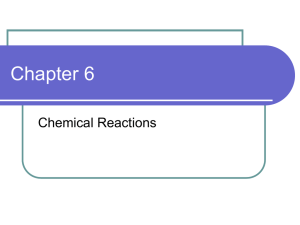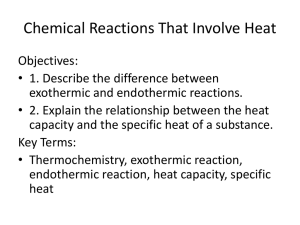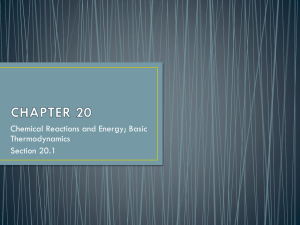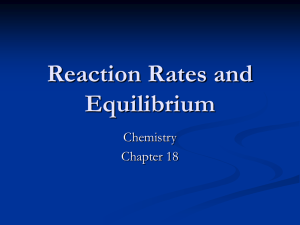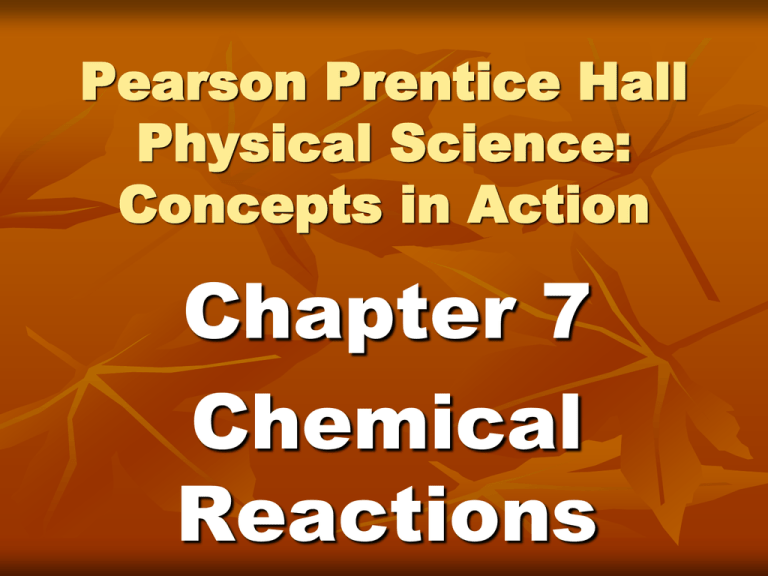
Pearson Prentice Hall
Physical Science:
Concepts in Action
Chapter 7
Chemical
Reactions
7.1 Describing Reactions
Objectives:
1. Interpret chemical
equations in terms of
reactants, products and
conservation of mass
2. Balance chemical equations
by manipulating coefficients
3. Explain what a mole is and
calculate molar mass
Reactants & Products
During a chemical equation, reactants
(the stuff you start with) are changed
into products (the stuff you finish
with)
The products actually are composed
of the same stuff you started with, but
the molecules have been rearranged
by chemical bonding to produce
completely new compounds with
unique physical properties
A basic chemical equation looks like
this:
REACTANTS
PRODUCTS
A chemical reaction is when
atoms interact with each
other to form new substances
What you put in = reactant
What comes out = product
Mass of reactants = mass of
products
MASS IS CONSERVED
Conservation of Mass
Definition: a chemical
equation is a chemical
reaction in which reactants
and products (separated by an
arrow) are expressed as
formulas
The Law of Conservation of
Mass states that mass is
neither created nor destroyed
during a chemical reaction
Balancing
Equations/Manipulating
Coefficients
In order to show that mass is
conserved during a reaction, a
chemical equation must be balanced
Definition: a coefficient is the
number that appears BEFORE a
formula
Recall that subscripts are used to
balance a formula
Coefficients are used to balance the
equation
Steps to balancing a chemical
equation:
1. Write out the chemical equation
2. Balance the most unusual
element or compound first, use
subscripts (charges) as a guide
3. Continue with other elements,
ending with the most common
Example: Balance the chemical
equation
ZnCl2 + HF → ZnF + HCl
Moles & Molar Mass
Definition: a mole is the counting unit
that measures the amount of
substance
A mole contains 6.02 x 1023 particles
(molecules, atoms, ions) of
substance
Definition: molar mass is the mass of
one mole
Molar mass is calculated by adding
up the atomic masses of each
element (multiplied by the subscript)
Example: CO2 carbon=12g oxygen x
2 = 32g & 12 + 32= 44g
The molar mass of CO2 is 44 g
7.2 Types of Reactions
Objectives:
1. Classify chemical reactions
as synthesis (also called
combination), decomposition
(decomp), single replacement
(single displacement) double
replacement (double
displacement) or combustion
reactions
Synthesis or Combination
Reactions
There are millions of
substances but only five
general types of reactions
The first is a synthesis
reaction where two
substances combine to form a
new more complex substance
general form
A + B → AB
Example: 2H2 + O2 → 2H2O
Decomposition
The second reaction type is
decomposition, where one large
substance breaks down to two or
more smaller substances
general form AB → A + B
Example: 2NaClO3 → 2NaCl + 3O2
Single Replacement
(Displacement)
The next reaction type is a
single replacement reaction
where atoms of one element
take the place of an element
in a compound
general form XA + B → A +
XB
example 3CuCl2 + 2Al →
2AlCl3 + 3Cu
Double Replacement
(Displacement)
A reaction type with a similar
name is the double
displacement where two
compounds exchange their
elements
general form AX + BY → AY +
BX
example : AgNO3 + HCl →
AgCl + HNO3
Combustion
The final type of reaction is a
combustion reaction where a
compound (usually a
hydrocarbon) and oxygen burn
With enough oxygen the products
are carbon dioxide and water
without enough the products are
carbon monoxide and water
general form A + O2 → H2O + CO2
example 2CH4 + 4O2 → 4H2O +
2CO2
7.3 Energy Changes in
Reactions
Objectives:
1. Describe the energy
changes that take place
during chemical reactions
2. Classify chemical reactions
as exothermic or endothermic
3. Explain how energy is
conserved during chemical
reactions
Energy Changes & Chemical
Reactions
Indications of a chemical reaction
include color change, gas
formation, and temperature
change
Atoms are just rearranged as
bonds are broken and new ones
formed
Breaking bonds requires energy
Forming bonds releases energy
Definition: chemical energy is
the energy stored in the
chemical bonds of a
substance
Chemical reactions involve
the breaking of chemical
bonds in the reactants & the
formation of chemical bonds
in the products
Q: Does breaking chemical
bonds require energy or
release energy?
Exothermic & Endothermic
Definition: Reactions that
release energy are exothermic
Definition: Reactions that
absorb energy are endothermic
ENERGY IS CONSERVED.
Example: for an exothermic
reaction energy stored in
bonds (chemical energy) =
energy released during
reaction
Conservation of Energy
Law of Conservation of
Energy: during a chemical
reaction, energy is neither
created nor destroyed
In exothermic reactions, the
chemical energy of the
reactants is converted to heat
plus the chemical energy of
the products
7.4 Reaction Rates
Objectives:
1. Explain what a reaction
rate is
2. Describe factors that affect
chemical reaction rates
What a Reaction Rate is
Definition: the reaction rate is
the rate at which reactants
change into products over
time
Reaction rates tell you how
fast a reaction is going
Factors that Affect Reaction
Rates
Reactions can happen at
different speeds
Factors influencing reaction
rates:
Temperature: rxn’s go faster
at higher temp
Surface area: large surface
area speeds up reaction
Large particles have less surface area
than the same amount of small particles
(blocks)
Stirring or agitation (shaking)
increases exposure of reactants
& increases reaction rate
Concentrated solutions react
faster (better chance of atoms
hitting each other)
Rxn’s go quicker at higher
pressure
Catalysts speed up the reaction
by lowering the energy needed
(do not influence the products)
Enzymes are biological catalysts
7.5 Equilibrium
Objectives:
1. Identify and describe
physical and chemical
equilibria
2. Describe the factors
affecting chemical equilibrium
Physical & Chemical
Equilibrium
Definition: equilibrium is a state in
which the forwards and reverse
paths take place at the same rate
Some reactions are reversible, a
double arrow indicates the
reaction can go either way
Equilibrium is when the amount of
reactants being turned into
products is the same as the
amount of products being turned
into reactants
reactants ↔ products
When a physical change does
not go to completion, a
physical equilibrium is
established between the
forward and reverse changes
H2O(l)
H2O(g)
Definition: a reversible
reaction is a reaction in which
the conversion of the
reactants into products can
happen simultaneously (at the
same time)
When a chemical reaction
does not go to completion, a
chemical equilibrium is
established between the
forward and reverse reactions
2SO2(g) + O2(g)
2SO3(g)
Q: What happens during
chemical equilibrium?
Factors Affecting Chemical
Equilibrium
LeChatelier’s principle
predicts what will happen to
equilibrium as a change is
introduced to the system
LeChatelier’s principle: if a
change is made to a system at
equilibrium the system will
shift to oppose or relieve the
change
CONDITION
• Temperature
•
•
Pressure
Concentration
•
•
•
REACTION
Increasing temp
favors the reaction
that absorbs
energy
Increasing
pressure favors the
reaction that
produces less gas
Increasing
concentration
favors the reaction
that produces less
of that substance
Example: N2 (g)+ H2 (g) ↔ NH3 (g)
+ heat
Which way will the equilibrium
shift when the reaction is
cooled? When the pressure is
raised? When more hydrogen is
added?



